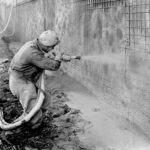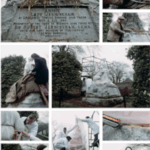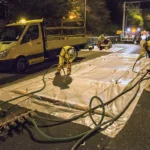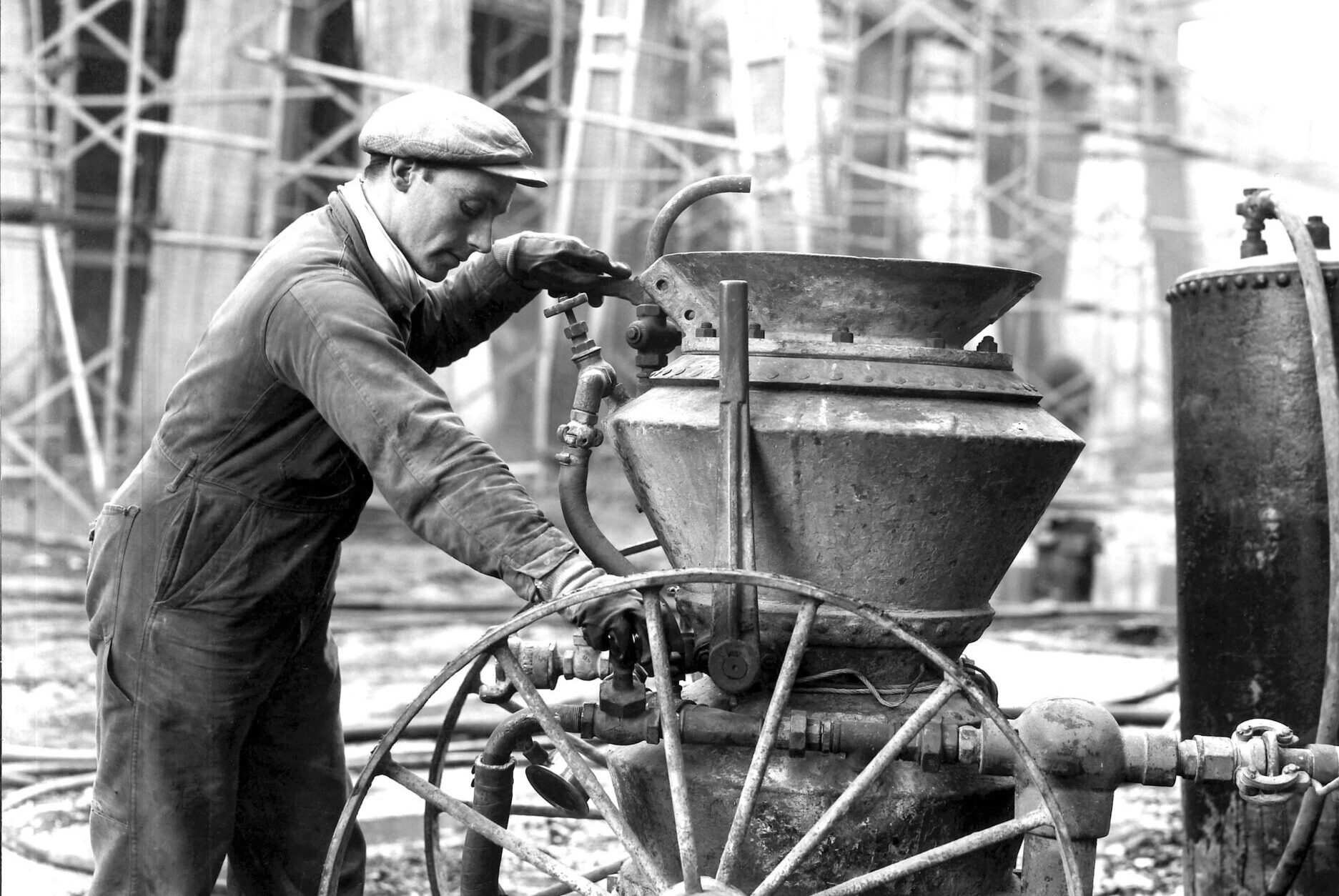Balvac Ltd was originally incorporated in Liverpool as Whitley Moran & Company Ltd in October 1933.
From its inception, the company pioneered innovative techniques such as gunite, sprayed concrete and resin injection for repairing concrete and masonry. In 1967, Balfour Beatty acquired the company, further expanding its expertise and reach.
As we’ve evolved from skilled gunite specialists into the highly technical structural repair company we are today, we’ve had the privilege of gathering a rich and varied archive—filled with artefacts, personal stories, anecdotes and other pieces of our company’s history.
-
1930s
1933 – Association formed
Thomas Whitley Moran and Timothy Charles Wallis formed an association to ‘manufacture and deal in gunite and all cementations, materials and products or other substances required for or used in the general business of the company.’ The company was formally incorporated on the 4th October 1933 with share capital of £2,500. The two directors each received one share worth £1.
1934 – Foundation and early developments
The company won its first contract for ICI on 9th February 1934. The work involved making gunite repairs to a steel tank at the Castner Kellner works in Runcorn. And the value of the project? The handsome sum of £19.

-
1940s
1943 – Gunite repairs to the concrete dams
Whitley Moran & Co. Ltd submitted bid number 635 in the sum of £20,000 to undertake gunite repairs to the concrete dams. Work commenced in March 1944.

-
1950s
1954 – Patent for new building material projection technique
On 7th September 1954, Whitley Moran & Co. Ltd was granted a patent number 765217 for improvements to the gunite process. This allowed coating materials to be applied to very low thickness to ‘one sixteenth or one thirty second of an inch’. The technique was titled, ‘Improvements in or relating to the projection of settable mixes of building materials to form a coating’. This pioneering invention was the forerunner to a number of other innovations such as spray applied levelling and fairing coats.

-
1960s
1962 – Meeting the challenge of Chicken Rock
Designed by David and Thomas Stevenson, Chicken Rock lighthouse was the last of the great pillar rock towers to be designed by the Stevenson family. The lighthouse marks an isolated rock just south of the Isle of Man and was first lit in 1875. Heavily damaged by fire in 1960, Whitley Moran & Co. Ltd was contracted to repair it in 1962 using gunite and pressure grouting. There was, however, a small logistics problem, due to its hazardous location it was impossible to approach by sea. Because of this all the men, plant and supplies required to complete the work were ferried to the lighthouse by helicopter. This meant an insurance bill of £200 for £100,000 of cover.

1967 – Whitley Moran & Co Ltd is acquired by Balfour Beatty
Whitley Moran & Co. Ltd was acquired by Balfour Beatty in 1967. Our main business was still gunite/shotcreting works, but we also started to carry out cementitious grouting, pointing and concrete repair works.
-
1970s
1975 – Featured on BBC’s “Tomorrow’s World”
In the early 1970s, James Milne was working for Balfour Beatty in East Pakistan and Bangladesh. Whilst there he developed a unique vacuum assisted process that was used to repair crumbling brick bridges. Further development by Balfour Beatty Power Construction Ltd. followed and the Balvac Process was patented in 1973. It was so innovative that the BBC featured it on its f lagship science television programme ‘Tomorrow’s World’ in 1975.

1977 – Patent for Vacuum Void Grouting
Watching the Tomorrow’s World programme featuring the Balvac Process was a gentleman named J.M. Guthrie, a member of the Engineering Intelligence Division of the then Ministry of Transport. This chance viewing gave rise to a new idea concerning road repairs, particularly filling voids under rocking road slabs. This new technique, known as Vacuum Void Grouting, was patented by James Milne and Balfour Beatty in 1977 and is still used extensively throughout the UK on both Highways Agency and local authority roads.

-
1980s
1986 – Balvac Whitley Moran Ltd formed
The Balvac business unit and Whitley Moran & Co Ltd merged to form a new single business.
1989 – Scaling the heights at Thorpe Marsh power station
Thorpe Marsh Power Station was a one gigawatt coal-fired power station near Doncaster in South Yorkshire, England. Originally built in 1959 it was nearing the end of its life when we were asked to complete some challenging repairs. Despite being coated with gunite to prevent their collapse, three cooling towers were found to have large vertical cracks. Our solution involved resin injecting the gaps and then externally prestressing the towers by wrapping them in corrosion proof parafil cables that were supported on stainless steel brackets bolted to the towers. The cables could then be tensioned to the correct stress to secure the integrity of the towers. The low weight of the cables was essential as the whole system had to be assembled at the top of the towers by steeplejacks working from cradles. Today we continue to undertake structured repair works to civil assets in the power sector.

-
1990s
1990 – Record breaking bridge lift
The Kingston Bridge is one of Europe’s busiest river crossings, carrying 150,000 vehicles a day high over the Clyde in the centre of Glasgow. The bridge is a key link in the west of Scotland’s motorway system and plays a vital role in Scotland’s economic life.
Hailed as a remarkable piece of engineering when it was built in 1970, daily vehicle crossings totalled 31,000 that year. By 1990, excess vehicle movements coupled with poor design and construction meant major defects had appeared in the bridge.
A decade-long programme was initiated to repair, renovate and strengthen the bridge. This operation involved 128 hydraulic jacks to lift the entire 52,000-tonne superstructure which earned it a place in the Guinness Book of Records as the “biggest ever bridge lift”. Woking alongside our colleagues in Balfour Beatty, we were involved throughout the design stage, providing specialist advice and post tensioning, plate bonding and vacuum-assisted injection of resins.
On conclusion of the project we received a letter of commendation from Glasgow City Council noting our ‘commitment to the successful outcome of the project which went beyond contract expectations and demonstrated the culture of their business to resolve problems and deliver solutions’.

-
2000s
2003 – Renamed as Balvac Ltd, a Balfour Beatty subsidiary
Balvac Whitley Moran Ltd later changed its name to Balvac Ltd, which is now our current trading entity. Today, Balvac Ltd operates as a wholly owned subsidiary of Balfour Beatty Group Ltd.
2009 – Steeling the show in Halton
Originally opened in 1961, the Silver Jubilee Bridge is one of the largest steel arch bridges in the UK and was regularly exposed to traffic volumes of over 80,000 vehicles per day. In 1977, the bridge was widened and renamed to coincide with the Silver Jubilee of Queen Elizabeth II. Balvac was first appointed to Halton Borough Council’s Bridge Maintenance Partnership contract in 2009, delivering over 30 packages totalling £23 million of work to the Silver Jubilee Bridge and surrounding bridge structures. Since 2015, Balvac has successfully negotiated and delivered a further c.£20 million of ongoing major maintenance works via the SCAPE Civil Engineering framework. Funding for the maintenance of the bridge was initially awarded by the Department of Transport, and subsequently via the Liverpool City Region Combined Authority. Works have included structural concrete repair and impressed current cathodic protection installations, maintenance painting, steelwork strengthening, stringcourse reconstruction and new steel parapets. In 2022, the project secured two industry accolades, winning both the Institution of Civil Engineers (ICE) Northwest ‘Constructability Award’ and the Bridge Design & Engineering ‘New Life Award’.

-
2010s – present day
2016 – present day – Extending the life of our nations infrastructure
Inspections, testing and structural health monitoring are essential to sustainably manage, maintain and future-proof our nation’s infrastructure assets for years to come. Via successive frameworks, Balvac has worked closely with National Highways to undertake inspections and condition surveys of their assets, to gather vital data and identify improvement or repair requirements. In 2022, Balvac was awarded a programme of asset inspections and testing across the M1/A1, A30/35 and A50/A564 Design Build Finance Operate (DBFO) concessions. Under a separate arrangement with National Highways, we also commenced further asset inspection works on bridge structures in 2023, including specialist post tensioning inspections and buildability reports. Balvac continues to deliver an impressive portfolio of structural repair, strengthening and protection projects across the strategic and local road networks, remaining focused on sustainably extending the life of our nation’s infrastructure.

